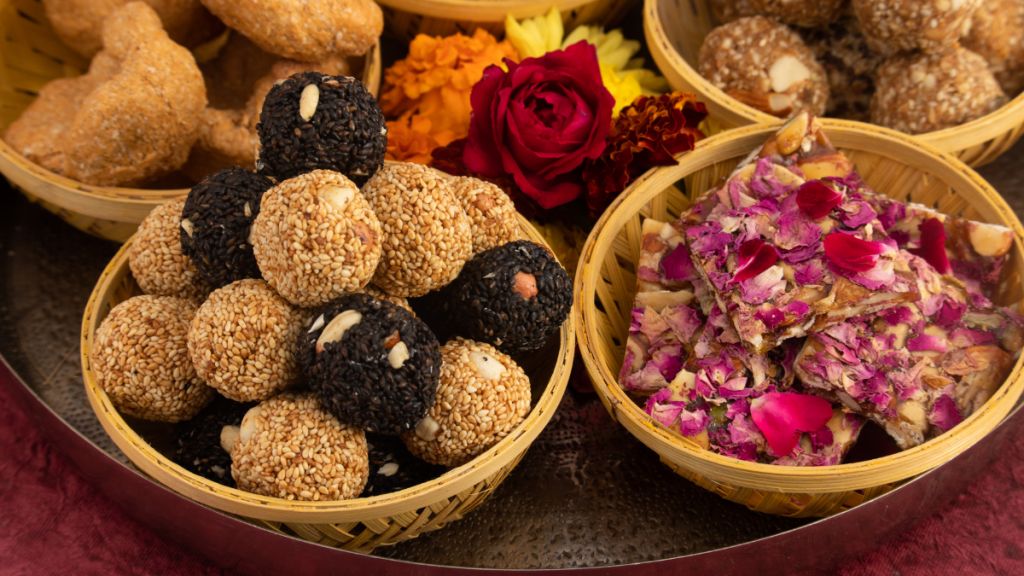
"Til Gul Ghya, God God Bola!" This traditional Maharashtrian greeting during Makar Sankranti reflects the spirit of the beloved festival. These words carry the essence of sharing, warmth, and harmony that define this vibrant harvest festival. But why are sesame (til) and jaggery (gud) so significant during Makar Sankranti? Let’s delve deeper into the festival and its age-old traditions.

The festival of Makar Sankranti
Makar Sankranti is celebrated on January 14 every year. This year, it falls on Tuesday. The festival marks the sun’s transition into the zodiac sign Capricorn (Makara) and its northward journey (Uttarayana). This astronomical shift indicates longer days and the end of winters, symbolising a time of renewal and hope. Unlike other Indian festivals based on the lunar calendar, Makar Sankranti follows the solar calendar, which ensures its date remains constant.
The festival coincides with other regional harvest celebrations like Lohri in Punjab, Pongal in Tamil Nadu, and Bhogali Bihu in Assam. Each of these festivals honours the beauty of nature, expresses gratitude to the Sun God, and celebrates community ties. Makar Sankranti is also a time for kite flying, bonfires, and savouring delicious festive dishes.
Why are Til and Gud essential to the celebration of Makar Sankranti?
Til (sesame seeds) and Gud (jaggery) are integral to Makar Sankranti festivities, symbolising unity, purity, and health. This combination holds deep cultural and nutritional significance.
Health benefits
Sesame seeds are a powerhouse of nutrients. Rich in protein, calcium, iron, and magnesium, they strengthen bones, enhance skin and hair health, regulate blood sugar levels, and boost overall immunity.
On the other hand, Jaggery is a natural sweetener. It is packed with iron, zinc, and selenium, aiding in blood purification, digestion, and immunity. Together, they help the body combat the winter chill and seasonal ailments.

Cultural symbolism
The act of sharing til and gud symbolises fostering warmth and harmony. The sweetness of jaggery represents kind words and good relations, while sesame signifies togetherness. This exchange is a reminder to strengthen bonds and spread positivity.
Culinary delight
The combination of til and gud inspires a variety of delectable sweets. These are not only a treat for the palate but also a way to bring families and communities together during the festive season.

Regional delicacies and traditions
The celebration of Makar Sankranti may differ across states, but til and gud sweets unite them in spirit. Some popular treats include:
Maharashtra: Til Gul Ladoos, Til Papdi, and Puran Poli.
Bengal: Nolen Gurer Payesh, Patishapta, and Moa (puffed rice and jaggery laddoos).
Punjab and North India: Til Revdi and Gajak.
In addition to these, the festival is marked by community gatherings, kite-flying competitions, and vibrant fairs. People dress in traditional attire, offer prayers to the Sun God, and exchange sweets with loved ones.

Recipe: Here's how to make Til Gud Laddoos at home
Ingredients:
Sesame seeds: 1 cup
Jaggery: 1 cup (grated)
Ghee: 1 tablespoon
Cardamom powder: ½ teaspoon (optional)
Method:
Dry roast the sesame seeds in a pan on low heat until they turn golden and release a nutty aroma. Set aside.
Heat ghee in the same pan and add grated jaggery. Stir continuously until the jaggery melts and forms a smooth syrup.
Add the roasted sesame seeds to the melted jaggery. Mix well until the sesame seeds are evenly coated.
Remove from heat and let the mixture cool slightly. Grease your palms with ghee and shape the mixture into small, round laddoos.
Let the laddoos cool completely before storing them in an airtight container. These laddoos can last up to 2 weeks.
Check out the recipe video below: